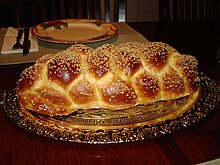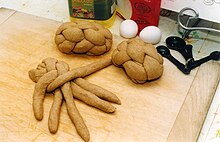Challah
The Hebrew word challah ( חַלָּה), in the plural challot (חַלָּוֹת), German Teighebe , referred to in Numbers 15,17-21 EU , where the first-fruits are described, the part of the bread dough that was separated as an offering and given to the priests of the temple. After the temple was destroyed in 70 C.E. At the moment it was determined by the rabbis that a small part of the dough should continue to be separated. However, since it can no longer be given to the priests, it is cremated instead. Taking challah is one of the three religious duties of women in Judaism.
Today the word challah stands for:
- the separate part described above from the dough
- Shabbat loaves (ostjidd. Challe , westjidd. Barches or Berches )
Challah / Barches
In the Ashkenazi Jewish tradition, challot are loaves of bread made from white flour, yeast, eggs and some fat - although the recipes, the number of “braids” and the shape vary depending on the custom and the occasion. Challot are mostly baked for Shabbat and Jewish holidays and are usually parve (neutral) so that they can also be eaten with meat. This is where they differ from conventional yeast plaits , which are prepared with butter and milk.
Shabbat bread
In the Ashkenazi tradition, two challot sprinkled with poppy seeds or sesame seeds are usually used on Shabbat and public holidays. The number is supposed to remind of the double portion of manna that the Israelites were given during their 40-year desert wandering (see Exodus 16 : 21-23 EU ). Before the start of the meal, after the blessing over the wine , during which the challot is covered, the blessing is spoken over the bread and the meal begins with a piece of challah sprinkled with a little salt.
Rosh Hashanah
On Rosh Hashanah , the Jewish New Year festival, special rules apply: Since one wishes for a "round year", the challot for the New Year festival are usually round - also to symbolize the annual cycle. In addition, one hopes for a "sweet year". Therefore, challot are often baked sweet, especially with raisins, and the piece of challah at the beginning of the meal is not eaten with salt, as usual, but dipped in honey.
Individual evidence
- ↑ Jacob Milgrom , Israel Burgansky and Judith Baskin: Hallah . In: Michael Berenbaum and Fred Skolnik (eds.): Encyclopaedia Judaica . 8th Volume, 2nd Edition, Macmillan Reference USA, Detroit 2007, pp. 277f. online Gale Virtual Reference Library.

